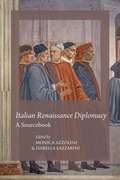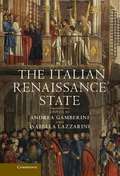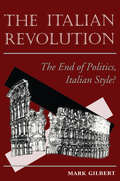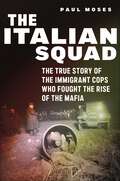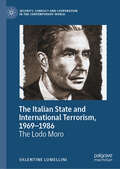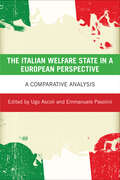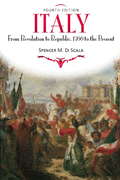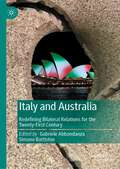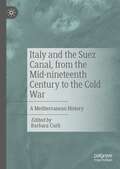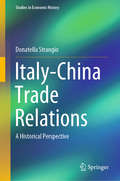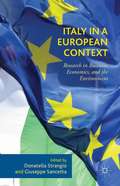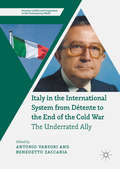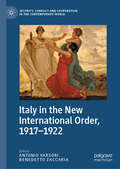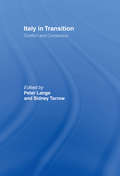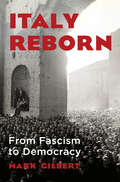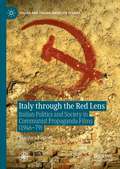- Table View
- List View
Italian Regionalism and the Federal Challenge: Reconciling Economic Regionalism and Solidarity (Federalism and Internal Conflicts)
by Erika ArbanThis monograph thoroughly illustrates the debate on federalism and regionalism as it emerged in Italy in the years preceding the unification of 1861 and then again in the early 1990s, a debate mainly centred on the deep socio-economic differences between the North and the South of the country. Torn between centripetal and centrifugal forces, the Italian regional model implemented with the 1948 constitution and strengthened in 2001 provokes questions that intersect with topical debates engaging scholars globally, potentially stimulating comparative discussions. While the future of Italian regionalism remains unclear, the Italian regional model combines lessons coming from different theoretical experiences, including federalism, sub-state nationalism, and the European unification process, representing a novel experiment fashioned by those who were looking for a compromise between unitary and federal schemes.
Italian Renaissance Diplomacy: A Sourcebook
by Monica Azzolini Isabella Lazzarini"Diplomacy has never been a politically neutral research field. The most recent research is moving away from diplomacy as an institutional tool and is increasingly viewing it as a social and cultural practice that enabled Europeans and non-Europeans alike to engage with each other in formal and informal, state and non-state contexts, through the elaboration of common languages, shared practices of communication, and political cultures. Since the nineteenth century, Renaissance Italy has been on the front line of diplomatic research. Italian polities have provided excellent case studies for the theory associating the beginnings of permanent diplomacy and the emergence of resident ambassadors with the process of state-building. Diplomacy during the period from about 1350 to about 1520 increasingly experimented with new ways of answering urgent political needs--to represent, negotiate, participate, and keep informed--by developing a broad range of innovative solutions that had to be integrated and absorbed within the traditional jurisdictional framework of medieval diplomacy. During the fifteenth century, diplomatic sources multiplied at an unprecedented rate, mostly due to the remarkable volume of dispatches exchanged between governments and envoys sent abroad for increasingly prolonged missions. The present book draws on these rich diplomatic sources, which are mostly unavailable to English readers. Most of the chapters present a selection of dispatches, either in their final version or in draft form; occasionally, instructions, letters of appointment, and final reports are added. The published and unpublished sources presented in English translation by the contributors to this volume cover a broad chronological and geographic arc. The aim is to illustrate the richness of diplomatic documents both for the study of diplomacy itself as well as for other less obvious areas such as gender and sexuality, crime and justice, art and leisure, and medicine. The potential for further study is practically infinite. The modest aim of this volume is to enrich classroom discussion and to bring diplomatic documents into focus for scholars and students interested in the Italian Renaissance more generally."--
The Italian Renaissance State
by Andrea Gamberini Isabella Lazzarini"This magisterial study proposes a revised and innovative view of the political history of Renaissance Italy. Drawing on comparative examples from across the peninsula and the kingdoms of Sicily, Sardinia and Corsica, an international team of leading scholars highlights the complexity and variety of the Italian world from the fourteenth to early sixteenth centuries, surveying the mosaic of kingdoms, principalities, signorie and republics against a backdrop of wider political themes common to all types of state in the period. The authors address the contentious problem of the apparent weakness of the Italian Renaissance political system. By repositioning the Renaissance as a political, rather than simply an artistic and cultural phenomenon, they identify the period as a pivotal moment in the history of the state, in which political languages, practices and tools, together with political and governmental institutions, became vital to the evolution of a modern European political identity"--
The Italian Revolution: The End Of Politics, Italian Style?
by Mark Gilbert<p>Since 1992, Italy has been rocked by the disintegration of its traditional ruling elite as dozens of leading politicians have been accused of corruption, extortion, and Mafia ties. The two linchpins of the former governing coalition, the Christian Democrats and the Socialists, have been shattered by scandal and humiliated at the polls. New political forces, such as the Northern League, have rushed to fill the vacuum. The traditional opposition, the Communist Party, changed its name to the Democratic Party of the Left in 1991 and has since emerged as the leader of a coalition of progressive forces that may yet prove itself as Italy's natural government. The neofascist Italian Social Movement, profiting from the chaos, has become the largest party in Italy's economically depressed South. All these political disturbances have taken place against a backdrop of mounting economic worries and an internecine war between the state and the Mafia. <p>These political convulsions could well be designated a revolution. Since the fall of the Fourth Republic in France, no Western nation has undergone such a dramatic period of upheaval. This clear and balanced book provides both a historical account of the circumstances that led to la rivoluzione italiana and an explanation of why it took place after decades of complacency.</p>
The Italian Squad: The True Story of the Immigrant Cops Who Fought the Rise of the Mafia
by Paul MosesThe unknown inside story of the NYPD’s Italian-born detectives who fought both powerful gangsters and the deeply ingrained prejudice against their own beloved immigrant communityThe story begins in Sicily, on Friday, March 12, 1909, at 8:45 p.m. Three gunshots thundered in the night, and then a fourth. Two men fled, and investigators soon discovered who they had killed: Giuseppe Petrosino, the legendary American detective whose exploits in New York were celebrated even in Italy.The Italian Squad, by veteran New York City journalist and historian Paul Moses, explores the lives of the nationally celebrated detectives who followed in the slain Petrosino’s footsteps as leaders of the New York City investigative squad: Anthony Vachris, Charles Corrao, and Michael Fiaschetti. Drawing on new primary sources such as private diaries and city, state, and federal documents, this dramatic narrative history follows the Italian Squad across the first two decades of the twentieth century as its detectives battled increasingly powerful gangsters, political obstacles and deeply ingrained prejudice against their own beloved Italian immigrant community.Vachris, Corrao, and Fiaschetti became, like Petrosino, famous for meting out tough justice to criminals who comprised the “Black Hand.” Beyond trying to prevent horrific crimes—nighttime bombings in crowded tenements, kidnappings that targeted children at play, gangland shootings that killed innocent bystanders—the Italian Squad commanders hoped to persuade society of what they knew for themselves: that their fellow immigrant Italians, so often maligned, would make good American citizens.In this explosive story, Moses carefully strips away the mythology that has always enveloped the Italian Squad and offers instead a nuanced portrait of brave but flawed men who fought the good fight for their people and their city.
The Italian State and International Terrorism, 1969–1986: The Lodo Moro (Security, Conflict and Cooperation in the Contemporary World)
by Valentine LomelliniThis book sheds light on the so-called ‘Moro Doctrine’, an Italian state security policy which has been portrayed in literature as an under-the-counter agreement made between Italy and Palestinian movement during the Cold War. The Moro Doctrine, or ‘Lodo Moro’ as it is known in Italy, aimed to protect the peninsula from Palestinian attacks by allowing terrorists to use Italian territory as a base for weapons and guerrilla fighters.Responsibility for the ‘Lodo’ was instrumentally placed on Aldo Moro, the five- time Prime Minister of Italy, after his death, and since then his name has become indelibly linked with the shame of having negotiated with Palestinian terrorists.Thanks to records collected from over twenty archives in Italy, the USA, France, Germany, Britain and Russia, concrete evidence shows that the significance of this agreement needs to be rethought. The author argues that the decision to adopt the Lodo was not solely made by Moro, but also involved key figures of the Christian Democrat and Socialist parties, various magistrates and even the President of the Republic. It illustrates how terrorism was used as an effective tool in international diplomacy to influence foreign and domestic policies.Offering a re-examination of Italian counter-terrorist policy, this book analyses how Italy responded to international terrorism during the Cold War, providing a useful read for those researching Italian and European history, Cold War studies, the history of international relations and diplomacy, and Middle-East history.
The Italian Welfare State in a European Perspective: A Comparative Analysis
by Edited by Ugo Ascoli and Emmanuele PavoliniThere is a need to understand the Italian welfare state, but as yet it has received little academic research attention. The Italian Welfare State in a European Perspective is the first book to explore the evolution of Italy's welfare state in the decades since the ‘Trente Glorieuses’ (1945–75). It offers a rare overview and analysis of the Italian situation based on an in-depth study of the main social policy fields (including education, higher education and taxation policies), a detailed analysis of the connection between policies and their outputs/outcomes and a comparative perspective framing the Italian case within the European context. This is the first English-language book to take a comparative look at the Italian welfare state as a whole since the 2008 economic crisis, It will be a valuable resource for academics and researchers, as well as students.
Italy
by Spencer DiscalaSpans three centuries of Italian history, weaving together the countryOCOs social, political, and economic developments and orienting them within the larger framework of European history. "
Italy: From the 1st to the 2nd Republic
by Stephen P. KoffThis textbook has been designed to provide students with an up-to-date and accessible introduction to the complexities of Italian politics during the 1990s. It will equip students with a sound understanding of the basics of Italian politics and government, and will provide clear and simple insights into the intricacies of Italian political behaviour.The comprehensive coverage includes: * an introduction to contemporary history, political geography and economic issues as well as Italian political values and attitudes. * a section on political behaviour which explores political parties, interest groups and the electoral earthquakes of the 1990s. * a section on government institutions and their roles, including discussion of the executive, the legislature, the judiciary and the subnational government. * analysis of Italy's often stormy relationship with the European Union * an exploration of recent events, such as attempts at institutional reform
Italy and Australia: Redefining Bilateral Relations for the Twenty-First Century
by Gabriele Abbondanza Simone BattistonThis book offers a novel and comprehensive reappraisal of current relations between Italy and Australia. For the first time, it expands the scope of analysis by encompassing and critically reviewing research avenues that have been understudied so far. In order to pursue this objective, it provides innovative analyses on bilateral history, reciprocal migration, socio-cultural ties, international relations and trade, comparative politics, and scientific cooperation.By adopting a multidisciplinary approach, this book makes a significant contribution to multiple disciplinary literatures, benefitting social science scholars, policymakers, and professionals working in a number of fields. Mindful of the wide scope and multidisciplinary nature of this innovative research, the editors oversee a careful balance of different theories, methodologies, sources, and data, in accordance with the conventions of each discipline employed in this volume. As a result, this book encourages a broader and more nuanced understanding of Italian-Australian relations in the 21st century.
Italy And East Central Europe: Dimensions Of The Regional Relationship
by Vojtech MastnyAs a medium-sized power in strategic proximity to east central Europe, Italy has sought a special role in the region following the collapse of Communist regimes there. Building on historical traditions and cultural affinities, Italy has drawn on its newly acquired economic power and important position within the European Union to develop an "Eastern" policy, for example, as originator of the Pentagonale project for regional cooperation. As a result, Italy has often been perceived by east central Europeans as a key country in their efforts to become more closely integrated with western Europe. More recently, however, both ethnic strife in the region and the collapse of Italy's own political establishment have cast doubt on the country's ability to play the role that many east central Europeans as well as Italians hope it can assume in the future European order. In this timely volume, leading European and U.S. experts examine the multifaceted dimensions of what has been in many ways a unique relationship in contemporary Europe.
Italy and Japan: How Similar Are They?
by Silvio Beretta Axel Berkofsky Fabio RuggeThis book provides an enlightening comparative analysis of Japan's and Italy's political cultures and systems, economics, and international relations from World War II to the present day. It addresses a variety of fascinating questions, ranging from the origins of the authoritarian regimes and post-war one-party rule in both countries, through to Japan's and Italy's responses to the economic and societal challenges posed by globalization and their international ambitions and strategies. Similarities and differences between the two countries with regard to economic development models, the relationship of politics and business, economic structures and developments, and international relations are analyzed in depth. This innovative volume on an under-researched area will be of great interest to those with an interest in Italian and Japanese politics and economics.
Italy and the Suez Canal, from the Mid-nineteenth Century to the Cold War: A Mediterranean History
by Barbara CurliConceived in the 1850s and opened to navigation in 1869, the Suez Canal’s construction coincided with Italy’s path to unification and its first foray into nineteenth-century globalization. Since then, the history of Italy and the Canal have intertwined in many ways, throughout in peace and war. This edited collection explores the fundamental technical, diplomatic and financial contributions that Italy made to the production of the Canal and to its subsequent development, from the mid-nineteenth century to the Cold War. Drawing from unpublished public and private archival sources, this book is the first comprehensive account of this long and multifaceted relationship, providing innovative perspectives on Italy’s diplomatic, economic, social, colonial and cultural history. An insightful read for those studying maritime, diplomatic or Italian history, this book contributes to a growing body of research on the Canal, which has largely emerged from international business, labour and social history, and offers new insights into the Euro-Mediterranean region.
Italy at the Polls 2022: The Right Strikes Back
by Fabio Bordignon Luigi Ceccarini James L. NewellItalian politics has changed course yet again. Thanks to the outcome of the 2022 general election, a coalition dominated, for the first time, by a party of the far right has taken office under Giorgia Meloni, the first woman to serve as prime minister in Italy’s republican history. Italy has always been a kind of ‘political laboratory’ for Western democracies – one in which new political phenomena have developed with considerable potency. Consequently, the electoral analyses presented in this book make it possible for the reader to understand the challenges and related consequences that established democracies are currently facing, beyond Italy.
Italy-China Trade Relations: A Historical Perspective (Studies in Economic History)
by Donatella StrangioThis book examines the political connections and trade relations between Italy and China, with particular emphasis on the second half of the 19th century and the period following the Second World War. In recent years, economic relations between the two countries have intensified as a result of increasing exchange and trade agreements, with positive impacts on their political and diplomatic relations. By studying original public sources such as the Archives of the Italian Ministry of Foreign Affairs, the Bank of Italy and the Central State Archives in Rome, the author offers a historical perspective on the evolution of the two countries’ economic and political ties. The respective chapters address e.g. the role of international governmental authorities, the role of the Italian Bank of China, the impact of trade agreements and foreign investment projects, etc. Given its scope, the book will appeal to scholars of economic history and international economics, as well as political scientists and legal scholars with an interest in international diplomacy and trade agreements.
Italy, Europe, The Left: The Transformation of Italian Communism and the European Imperative (Routledge Revivals)
by Vassilis FouskasPublished in 1998. Was the Italian Communist Party (PCI) a typical Social Democratic party in tune with the programmatic principles of the Second International? What is the appropriate context within which the strategies of 'historic compromise' and Eurocommunism in the 1970s can be analyzed and understood? In what form and to what extent has the process of European integration and the crisis of Keynesianism contributed to the transformation of the party in 1989-91? What caused the collapse of the ruling political class of the First Italian Republic? Why did the transformed PCI, the PDS (Democratic Party of the Left), fail to lead the transition to the Second Italian Republic between 1992 and 1996? Is there any link between the party’s historical factions and the current divisions in the Italian Left? Is it possible to theorize and speculate upon these divisions? Italy, Europe, the Left seeks to answer these questions, debating conventional views and examining the extent to which the end of the Cold War has contributed to a redefinition of the Left’s identity in Italy and Europe. The exemplary methodological framework and the wider European perspective adopted throughout, make the book an indispensable reading in the field of Italian and European politics.
Italy from Crisis to Crisis: Political Economy, Security, and Society in the 21st Century (Routledge Advances in European Politics)
by Matthew EvangelistaItaly from Crisis to Crisis seeks to understand Italy’s approach to crises by studying the country in regional, international, and comparative context. Without assuming that the country is abnormal or unusually crisis-prone, the authors treat Italy as an example from which other countries might learn. The book integrates the analysis of domestic politics and foreign policy, including Italy’s approach to military interventions, energy security, economic relations with the European Union (EU), and to the NATO alliance, and covers a number of issues that normally receive little attention in studies of "high politics," such as information policy, national identity, immigration, youth unemployment, and family relations. Finally, it puts Italy in a comparative perspective – with other European states, naturally – but also with Latin America, and even the United States, all countries that have experienced similar crises to Italy’s and similar – often populist – responses. This text will be of key interest to scholars and students of, and courses on, Italian politics and history, European politics and, more broadly, comparative politics and democracy.
Italy in a European Context: Research In Business, Economics, And The Environment
by Donatella Strangio Giuseppe SancettaItaly in a European Context
Italy in International Relations
by Emidio Diodato Federico NigliaThis book aims to provide an overview of Italian foreign policy from the moment of unification to the establishment of the European Union. Three turning points are crucial in order to clarify Italy's foreign policy: 1861, the proclamation of the Italian Kingdom; 1943, when Italy surrendered in World War II; 1992, the signing of the Maastricht Treaty. The international position of Italy continues to be an enigma for many observers and this fuels misinterpretations and prejudices. This book argues that Italy is different but not divergent from other European countries. Italian elites have traditionally seen foreign policy as an instrument to secure the state and import models for development. Italy can still contribute to international security and the strengthening of the EU. At the same time, Italy is not a pure adaptive country and has always maintained a critical attitude towards the international system in which it is incorporated.
Italy in the International System from Détente to the End of the Cold War
by Antonio Varsori Benedetto ZaccariaThis edited collection offers a new approach to the study of Italy’s foreign policy from the 1960s to the end of the Cold War, highlighting its complex and sometimes ambiguous goals, due to the intricacies of its internal system and delicate position in the fault line of the East-West and North-South divides. According to received opinion, during the Cold War era Italy was more an object rather than a factor in active foreign policy, limiting itself to paying lip service to the Western alliance and the European integration process, without any pretension to exerting a substantial international influence. Eleven contributions by leading Italian historians reappraise Italy’s international role, addressing three complex and intertwined issues, namely, the country’s political-diplomatic dimension; the economic factors affecting Rome’s international stance; and Italy’s role in new approaches to the international system and the influence of political parties’ cultures in the nation’s foreign policy.
Italy in the New International Order, 1917–1922 (Security, Conflict and Cooperation in the Contemporary World)
by Antonio Varsori Benedetto ZaccariaThis edited collection offers the first systematic account in English of Italy’s international position from Caporetto – a major turning-point in Italy’s participation in the First World War – to the end of the liberal regime in Italy in 1922. It shows that after the ‘Great War’, not only did Italy establish itself as a regional power but also achieved its post-unification ambition to be recognised, at least from a formal viewpoint, as a great power. This subject is addressed through multiple perspectives, covering Italy’s relations and mutual perceptions vis-à-vis the Allies, the vanquished nations, and the ‘New Europe’. Fourteen contributions by leading historians reappraise Italy’s role in the construction of the post-war international order, drawing on extensive multi-archival and multi-national research, combining for the first time documents from American, Austrian, British, French, German, Italian, Russian and former Yugoslav archives.
Italy in Transition: Conflict and Consensus
by Peter Lange and Sidney TarrowThis is a reproduction of a book published before 1923. This book may have occasional imperfections such as missing or blurred pages, poor pictures, errant marks, etc. that were either part of the original artifact, or were introduced by the scanning process. We believe this work is culturally important, and despite the imperfections, have elected to bring it back into print as part of our continuing commitment to the preservation of printed works worldwide. We appreciate your understanding of the imperfections in the preservation process, and hope you enjoy this valuable book.
Italy Reborn: From Fascism to Democracy
by Mark GilbertA brilliant, meticulously researched account of the birth of Italian democracy after Mussolini. The rebirth of Italy after the Second World War is one of the most impressive political transformations in modern European history. In 1945, post-fascist Italy was devastated by war, and its reputation in the international arena was nil. Yet by December 1955, when Italy was admitted to the United Nations, the nation had contested three acrimonious but free general elections, had a flourishing press, and was a leader in the rebuilding of Europe. This is the dramatic story told by Italy Reborn. It charts the descent of Italy into Fascism, the scale of the wartime disaster, the Italian resistance to Nazi occupation, the horrors of civil war, and the establishment of the Republic in 1946. The Cold War divided, in 1947, the coalition of parties that had led the resistance to Fascism and Nazism. The book’s final chapters deal with the consolidation of Italian democracy and with the statesmanship of Alcide De Gasperi, the premier from December 1945 to August 1953. The book persuasively argues that De Gasperi deserves more credit than he has typically been accorded for Italy’s postwar democratization and shows how Italian democracy was constructed on a sound foundation—which is why it has been able to survive its many postwar crises. Largely based on contemporary Italian sources, Italy Reborn is both an original account of this crucial period in Italian history and a remarkable example of how democracies are made.
Italy through the Red Lens: Italian Politics and Society in Communist Propaganda Films (1946–79) (Italian and Italian American Studies)
by Gianluca FantoniThis book offers the first comprehensive analysis of the role of cinema in the communication strategy of the Italian Communist party (the PCI). It examines the entire period during which the party had a systematic and organized approach to cinematographic production, starting with the early experiments in 1946 and concluding with the closure of PCI film company Unitelefilm at the end of the 1970s. Its analysis sheds light on a range of issues, such as the relationship between the party and Italian intellectuals, the Stalinist imprint of the Italian Communist Party and the historical significance of the Salerno turn, the PCI’s relationship with the student movements in 1968 and 1977, and the PCI’s response to the rise in political violence in the 1970s. Ultimately, the book demonstrates that cinema was essential to the PCI’s propaganda effort.
Italy Today: The Sick Man of Europe
by Andrea MammoneItaly Today represents one of the most comprehensive examinations of contemporary Italy. It is a provocative and an innovative collection that aims to highlight the current ‘crisis’ of the country through an analysis of several different ‘dark shadows’ of contemporary Italian society. Italy already had a long history of ‘unsolved’ issues, several chronic problems and contradictions that have been ignored for a very long time, during which they have assumed dramatic proportions and gravity. The peninsula has now become the ‘Sick Man of Europe’, a country facing a veritable decline also caused by apparent incapacity and difficulties of the ruling economic, political and social elites. Discussions include: an evaluation of the current predicaments of the political system analysis of emerging mafias, including new powerful crime organizations such as ‘Ndrangheta issues surrounding the ongoing presence of Fascism examination of the recent xenophobic tensions discussion of problems associated with the missed opportunity of the EU funding, and the increasing regional economic gaps outline of the systemic troubles of Italy’s economic and industrial system. Written by leading experts in the field and covering a wide range of topics, this collection is essential reading for all those seeking to understand the issues and problems that are facing contemporary Italy.

